Religious Nonconformity in Glossop.
This article is based on the notes of Robert Hamnett, originally published as a series of articles in the Glossop Advertiser in July 1913.
How the Independents became established.
The Reformation in England was not as thorough as on the continent of Europe; there it arose through the conscientious convictions of Martin Luther and others.
In this country the refusal of Pope Clement VII. to grant Henry VIII. a divorce from Queen Katherine, incensed Henry, and in revenge he instituted aggressions on the Roman Catholic authority in this country, robbed their monasteries, and executed the Carthusian Monks of the Charterhouse, which deed led Pope Paul III. to launch his Bull against him, one of the most terrible ever issued by any Pope against any individual.
In Edward VI.’s reign, in 1549, the Act of Uniformity was passed, which attempted to have a uniform system of worship throughout the country, but this did not meet with the approval of many learned and religious men, who desired a simpler form of Church government and worship, and preferred to follow the pure Word of God; hence they were known as Puritans; and in all manners of ways they tried to inculcate in others a desire to follow their precepts and example. This led Queen Elizabeth, in 1558, to pass an Act against uninfluenced preaching.
In 1588 came the invasion of the Spanish Armada, which created a very bitter feeling against Roman Catholics in general, and was the cause of many Acts of oppression being passed against them. The Puritans increased in numbers and influence, and in 1604 they made a strong and earnest attempt to have the forms of worship reformed. Some of their objections were against kneeling at the Sacrament; Sign of the Cross at Baptism; bowing at the Name of Jesus; wearing surplices, etc. They failed in their object, and 300 of them left the country, some to Holland, and others in the "Mayflower" to America.
Eventually they obtained power. Charles I. lost his head, and for 11 years and they ruled the country with a rod of iron.
With the Restoration in 1660 came a reaction, and the country was plunged to the opposite extreme.
The first Parliament contained very few Puritan representatives, and was mainly composed of young men who had experienced the Puritan mailed fist, and were now in for retaliation, and the Uniformity Act came into force on St Bartholomew's Day, 24th of August, 1662.
This Act, amongst other requirements, required every clergyman "to read before this day, publicly, the morning and evening prayer from the revised Prayer Book, and to declare their unfeigned assent to everything contained in the book." From 1,600 to 2,000 - authorities differ as to the number - resigned their livings, amongst whom was Rev. William Bagshawe, M.A. Vicar of Glossop, and afterwards known as “the Apostle of the Peak.” He was one of the Bagshaws of Ford Hall, and after his expulsion he laboured unceasingly for the cause for which he had sacrificed so much. Fortunately, his financial position was such that it enabled him to do so.
During the 11 years he had been Vicar of Glossop he had made many friends and converts in the parish, and these supported him secretively, for it was against the law to meet openly for worship. He died in 1702, aged 75, but during the last 26 years of his life he had the satisfaction of seeing the cause he had so much at heart firmly established at Chinley, from whence it spread to surrounding villages.
After the toleration act of 1690 many dwelling-houses in the parish were licensed and registered as places where religious meetings could be held; a list of these would be most interesting.
In 1690 Henry Kirke and John Robinson had their houses licensed, and in 1692 Mr Thomas Swindells of Mellor, “His barn, schoole house in possession of Mr Cheetham." In the parish church grounds are several entries relating to Harrop Chapel.
September 16th, 1761:- Baptised Nathan, son of Nathan Wood, of Harrop Chapel.
This must have been a dwelling-house or building licensed by a Mr Harrop.
In Taylor's "Echoes of Glossop-Dale" are several references to Harrop's, who were strong and devout Nonconformists, and local preachers on the New Mills Wesleyan Local Preachers' Plain, Glossop being originally in that Circuit.
My first authentic information about the local Independents is that their first regular meeting place was in a room over the Howard Arms Stables in Ellison Street, the entrance being up some stone steps. I remember the building very well; the Union Offices are now erected on the site.
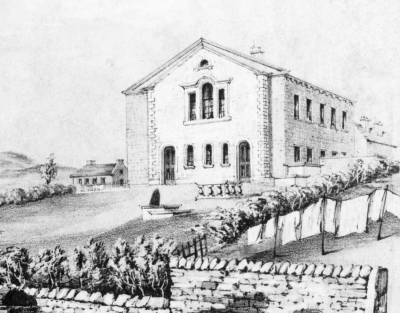
Littlemoor Chapel.
In July, 1811, the Littlemoor Independent Chapel was opened. A lease from George Hadfield, senior, (one of the Hadfields' of Simmondley Hall, and originally of Hadfield Hall, see Hadfields of the Old Halls) was obtained for 500 years; the land was described as The Little Moor, common land, allotted to Samuel Dearnley, and the dimensions were: North, 81 yards, road to Whitfield; East, 81 yards, Howard's land; West, 30 yards, Chapel-en-le-Frith Road; and South, 30 yards, George Wagstaffe’s land, containing altogether 2,452 square yards.
The Trustees were:
George Hadfield, Esq. (died 20th September, 1831);
Moses Hadfield, Esq;
James Sheppard, clothier;
Thomas Shaw, yeoman;
John Kershaw, cotton manufacturer;
William Kershaw, cotton manufacturer.
In 1845 the sole surviving trustee was John Platt, of Hayfield, who appointed the Rev. Thomas Atkin; James Beever, grocer; John Kershaw, Hurst; Edward Dyas, cabinet maker; Anthony Higginbottom, grocer; and John Bennett, weaver, of Turn Lee.
The Rev. Joseph Harrison was ordained the first pastor on 6th July, 1814. In June, 1825, the Rev. J Fielding, the pastor, resigned.
On 26th October, 1838, the pastor, Rev. George Partington, died, aged 65; and the Rev. Thomas Atkin came from Wigan to be the pastor. He was ordained pastor of St Paul's Chapel, Wigan, on Wednesday, 7th August, 1833. He was a strong Radical, and took an active and vigorous part in local and Imperial politics, and in consequence he did not escape the opposition scribes, who issued the following against him. It is a fair specimen of how fifty years ago Glossop politicians regarded each other.
Election Squib - “To the Electors of North Derbyshire.”
Gentlemen, - As I am very wishful to gain prominence and power - to take a lofty stand in the great ocean of political strife, I am induced by my feelings of ambition and the promptings of self-sufficiency, to offer myself as a candidate for your suffrages at the ensuing election. I am well known amongst you, having for many long years been navigating the smaller and less important, though not always calm and peaceful seas of my own immediate locality. As a political agitator I am also well known to you, having as far as possible, on all occasions of party strife, endeavoured to put aside my cloth and choker to take part in these unclerical matters.
In principle I am a Rad, one of those who would turn the Constitution upside down, yet I have sufficient regard for myself and party never to let any power pass into the hands of that well-meaning honest class of men, denominated by John Bright, the “Resideum.” I mean the working men of England. But I would have regard to such firebrands and peace breakers as Finlin and Co., who leave their families to be fed by the ratepayers of England while they themselves are resisting authority and subverting order.
I should still endeavour, as I do at present, to hold men's consciences and influence their minds against their wills.
I would support any policy that would rob one party to please another. I hold it no sin for a man to break his promise after he has given it to another.
I maintain that the Church is the nation, and the nation is the Church, but am unable to prove it. If you do me the honour to elect me, I shall be glad to supply all of you with a newspaper free, a specimen of which was given away yesterday, the full control of which is in my hands. I hold it is no sin at an election to tell bare-faced untruths about my opponents, if they will serve my party.
I have, Gentlemen, the Honour to be
Your obedient Servant,
Thomas Roundhead.
Whigmoor, Nov. 26, 1368.
Committee Rooms, Norfolk Arms Bar, where I may be seen during any hour of the day or night.
Mr. Atkin did not always agree with all his congregation, and during one of the disputes the following lines were published :
The Battle of Littlemoor
'Twas on the 28th of March, in the year one eight eight three,
That on the heights of Littlemoor the flower of chivalry
Met for a doughty contest, the victory to decide,
Of who should be the masters there, and valiant men took side.
The well-known form of Pigskin, with his deep and swarthy glow,
With head erect, and kindled eye, glared fiercely on the foe,
And bearded amazons were mixed with petty champions there,
And the Norfolk lion switched his tail and roused him from his lair.
From East to West, from North to South, the motley crew poured in,
And sound of cannon, blunderbuss and noisy culverin
Was heard, and round the banner of Pigskin were arrayed
Josiah and the Singer's sons and great was the noise they made.
When all the troops were marshalled which Pigskin had called forth,
He frowned and spoke before them all of his excellence and worth,
For thirty mortal minutes he wrestled with his foes,
Nor gave them time or chance for breath, while fiercely fell his blows.
When he had ceased, the Black Prince rose, and for a time essayed
To speak a word, but vain - for so great a row was made
By the champion's lively parasites, that not a sound was heard,
And when he sought to make things clear, they would not hear a word;
They said his figures all were wrong; he was a renegade,
Had taken stories out of school, and had exposure made
Of the faults; of pastor Pigskin, and his petty little friend,
And they would not listen to him, unless he made amend.
By full confession of his faults, in penitential cloth;
And because he would not do it the saints' waxed very wroth,
Josiah mounted on a stool, and commenced to make a speech,
But was rudely interrupted by hiss and shout and screech;
And the deacon's squeaking penny trump was heard above the din
Which came from saintly throats, like roar of rattling culverin.
And voices bade the deacon mount up upon a tub,
And they told the meek Josiah to go t' Liberal Club.
And mid the roar, the turmoil, and the cries that rent the air,
The Black Prince with his squire rushed off in mute despair.
Then fierce the host of Pigskin, who'd been summoned far and wide,
And drilled and marshalled silently, this Contest to decide,
Turned round upon a brother, and him they henchman called,
And while they closed around him, their leader they extolled,
But to the sire's assistance rushed forth a valiant son,
And Pigskin and the youngster were left there one to one .
And dire the conflict would have been, but the merry Andrew flew
Between the struggling combatants, and championed the view
That those who had the trusteeship could not go wrong or err,
That Pigskin should more quiet be, nor with them interfere.
Then another to the rescue sprung, his aim the Making peace.
And craved from all the brethren from strife a short release;
And midst the wailings and the cries of all the saintly crew,
The Pigskin and his myrmidons front out the fight withdrew.
But when they'd cleared the battlefield and the barrier got outside.
The struggle was renewed again, with stubbornness and pride;
And as I hurried home to bed I heard, 'mid many a grin
A voice say if they did not move, he'd be bound to run them in.
The battle thus was drawn, but both sides the victory claim,
And the troops of Pigskin, and Black Prince, both say they've won the game,
But those who watched the struggle, said it ended in a draw,
And 'tis said that what was then commenced will be sure to end in law.
Johnny Gilpin.
In 1840 the Littlemoor Schools were built in King Street, now converted into cottage houses. The present day and Sunday Schools were built in 1881.
In 1852 the Independents opened, on the 14th March, 1852, Brookfield Schools, and on the 9th July, 1854, the first. sermons were preached in aid of the schools by the Rev. R. Calvert, of Hyde ; the collections amounted to £16 4s. 3d., and eventually a chapel was built, which was mainly supported by the Shepleys, of Brookfield.
Dissensions arose amongst the congregation at Littlemoor Chapel, and a number seceded and opened a room in Charles Street, now part of Mr. S. Goldthorpe’s grocer’s shop. They held their first congregational tea party on the 14th July, 1860. Afterwards, the room becoming too small or inconvenient, they removed to the Temperance Hall, now the Liberal Hall, the opening service, on the 14th February, 1864, being conducted by Mr. Adamson, a revivalist. Mr. H. Flint was one of the principals, and on the 25th of December, 1865, Mr. Lot Woodcock presented him with a family Bible:- "Presented by the Church of Christ, worshipping at present in the Temperance Hall, Glossop, to Mr H Flint, Senior Deacon, as a token of love and gratitude for his arduous and unceasing labours during the past seven years; praying that the Great Head of the Church may continue to bless him and his family and spare him long in his labour of love.”
On Good Friday, 1866, Mr W. H. Reid was ordained pastor; and on 22 July, 1866, the 8th anniversary sermons were preached by the Rev G Pill, of Jedburgh.
Mr Flint and the Rev. W. H. Reid did not agree, and Mr Reid resigned. The correspondence which ensued, and which appeared in the local papers, was very bitter, personal, and lacked charity.
On 18 February, 1868, a lease was obtained from Mr Thomas Wagstaff, valuer, of Glossop, for 999 years, of land containing 1000 square yards at an annual chief rent of £8 6s. 8d., and the Mount Pleasant Chapel, St Mary's Road, was opened on 14th March, 1869.
A plot of land opposite to Littlemoor Chapel was wanted for the site, but the Estate Agents would not grant it, and very wisely too, for religious differences do not help to make converts.
The Methodists, Foundation of their Chapels & Schools and their early struggles.
Methodists was a title applied to John and Charles Wesley, George Whitefield, and other students at Oxford "from their strict adherence to method, from their care in keeping the appointed festivals and fasts of the church, from the regularity and strictness of their lives, and the methodical observance of their religious duties.”
The fact that the Rev. John Wesley preached at Bridgefield on 29 March, 1761 and he and his followers at different times and places in the district, accounts for Methodism being established in the district. Like all other movements, "the two or three gathered together" had to meet in the most convenient places, and, gathering strength slowly, but surely, became emboldened by their numbers and gave more publicity to their views.
In Glossop their meeting place was in an upper room belonging to Jonathan Wadsworth, of the Old Cross (he was the postmaster), and the entrance was up an outward staircase. I remember seeing it, but the houses are now pulled down. They were erected by J.B., 178- the last figure was not decipherable, I could not make it out.
It must be taken into consideration that during the early establishment of the various Dissenting Bodies, handloom spinning and weaving, was the major occupation of operatives, and as these occupations could be followed from the first appearance of daylight to as long as people could see, or even after that by candlelight.
Little time could be spared to attend religious services. When a noted preacher, however, was known to be coming to the district, all work was practically stopped; those who were of the same views as the preacher attended and took with them all they could persuade to attend, and others attended for curiosity's sake to see and hear those of them they had so often heard about.
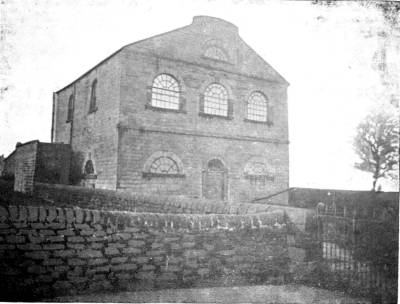
The first Wesleyan Chapel in Hadfield.
John Thornley, cotton manufacturer, Hadfield, built the first Wesleyan Chapel in Hadfield in 1804, in the fulfilment of a vow, a full account of which appears in "Echoes of Glossop-dale." The school was established in 1808, enlarged in 1822, rebuilt in 1854, and sold to the Glossop education authorities, who have built the handsome school on the site.
The present chapel was erected in 1878, the foundation stones were laid in 1877 by Joseph Bailey, Esq., Tom Milburn, Esq, Samuel Rowbottom, Esq., (Mayor), James Sidebottom, Esq., Richard Tremlow, Esq., and William Barker.
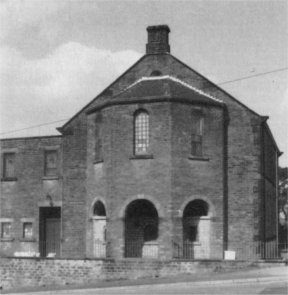
Haque Street Chapel in Whitfield.
In 1812 the Wesleyans in Glossop were a divided body, and a race took place between the old Glossop Wesleyans and Whitfield Wesleyans which could have their chapel built first. The chapel at Whitfield was opened on 26 October, 1813. The Methodists at that time were financially poor, and the present barn-like structure gives us a general idea of what the early chapels were like, practically four walls with windows in.
It is a disgrace to Wesleyanism that this place of worship has not been rebuilt, as it is the most unattractive place of worship in the district.
(Mr Hamnett was obviously taken to task regarding this description because he wrote in the following article: My remarks last week regarding the outward appearance of the Whitfield Wesleyan Chapel seem to have given offence to some of the worshippers. I meant none. All the places of worship in the district have either been rebuilt, enlarged, or new fronted, except the Whitfield Wesleyan Chapel, and my remarks were intended to spur up the whole of the Wesleyans in the district to unite and endeavour by united effort, to build a new chapel there, in accordance with present ideas of what such places should be.)
The land was leased for 999 years at the chief rent of 11s. 3d. per annum, not an heavy encumbrance. The trustees were:-
William Cliffe, yeoman, Whitfield.
Samuel Ridgeway, cotton manufacturer, Chunal.
William Robinson, plaisterer, Whitfield.
John Cook, cotton manufacturer, Whitfield.
John Bennett, clothier, Whitfield.
James Bennett, clothier, Whitfield.
Edward Bennett, clothier, Whitfield.
Samuel Robinson, plaisterer, Whitfield.
William Bowers, cotton spinner, Whitfield.
John Wood, clothier, Whitfield.
The school was erected in 1832, and rebuilt in 1885, and the foundation stones were laid by Capt. E Partington, Alfred Leech, John Sellars, and W S Rhodes, J.P.
The Old Glossop Wesleyans followed suit by building their chapel in 1813, and in 1824 they erected their school. The lease is dated 18th of May, 1825, and was leased to William Robinson, shopkeeper, Glossop, the trustees being:-
John Harrison, cotton spinner, Glossop.
James Hall, tailor, Glossop.
Isaac Linney, cotton spinner, Glossop.
William Thorpe, joiner, Glossop (Thorpe Street was named after him).
William Bowers, cotton spinner, Glossop.
John Shaw, cotton spinner, Glossop.
John Goodwin, woollen clothier, Glossop.
John Howard, cotton spinner Glossop.
Thomas Winterbottom, butcher, Glossop.
John Ridgway, cotton spinner, Glossop.
Charles Hampson, cooper, Glossop.
James Bennett, tallow chandler, Glossop.
Edward Wagstaffe, cotton spinner, Glossop.
William Bramhall, cotton spinner, Glossop.
John Rusby, surgeon, Cross Cliffe.
The boundaries of the plot of land were East, rivulet of Glossop Brook; West, gardens of Joseph Wood, William Chatterton, and John Hadfield; North, garden of Joseph Hadfield; South, premises of Thomas Wilkinson.
The school was rebuilt in 1876, the foundation stones being laid on November 13, 1875, by Thomas Swindells Bowden, William Hurst, William Shepley, Esq, J.P., William Sargentson, Samuel Rowbottom, and Thomas Platt.
The Wesleyan body has always had enthusiastic members of the working classes, who have made up for their lack of wealth by their industry in raising "the sinews of war" – money.
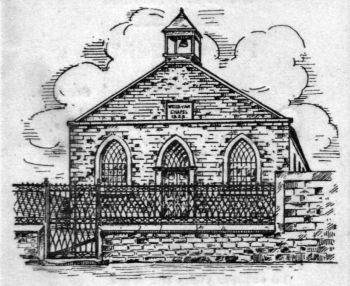
Original Padfield Methodist Chapel, Post Street.
On 6th March, 1829, the Padfield Wesleyans obtained a 99 years lease of a plot of land to John Siddall, cotton spinner, Padfield, on behalf of the following trustees:-
John Harrop, book-keeper, Hadfield.
Reuben Warhurst, schoolmaster, Padfield.
John Swindells, mechanic, Hadfield.
William Wood, hatter, Hadfield.
George Dewsnap, cotton card manufacturer, Padfield.
Alvin Willis, carder, Brookfield.
Peter Harrop, mechanic, Hadfield.
Joseph Barber, shoemaker, Padfield.
Joseph Harrop, schoolmaster, Padfield.
Thomas Warhurst, shopkeeper, Padfield.
Thomas Broadbent, cotton spinner, Padfield.
Thomas Warhurst, cotton spinner, Padfield.
Joseph Swindells, cotton spinner, Hadfield.
The present edifice was built in 1880, the foundation stones being laid by William Crowther to the memory of Joseph Siddall, on behalf of the teachers and scholars; laid by the Choir’s memory of James Normanton, late leader; and by James Rose, William Fielding, Cllr. James Sargentson, on 26 March, 1880.
Glossop was increasing rapidly and mostly Westerly, the Howard Town Wesleyans began to form a congregation of their own, and in August, 1841, held their first service in a room on the ground floor of Shepley Mill, which at that time was partially empty. After struggling for many years sufficient money was raised to enable them to build a chapel on the site of an old reservoir of Shepley Mill. The chapel soon proved too small and the present chapel was erected, the foundation stone being laid by S. Turnbull, Esq., of Manchester. The chapel was opened at Easter, 1861.
The Wesleyan body, like other Nonconformists, had had internal dissensions, which has resulted in many sections being formed under various names. One section known as the “Warrenites" held at their meeting in a cottage at Wellgate, and there special services in the universal School. They began in 1836 to seriously consider having a chapel of their own. James Hall, tailor, and John Linney were two of the most active members, Mr Hall lending the Trustees £200 besides having £40 in shares.
The chapel was opened in 1837 in connection with the Wesleyan Methodist Association. The preachers were - in the morning the Rev. Samuel Warren, L.L.D., and in the afternoon and evening Robert Echett, Esq, of London. On the 9th December, 1860, the present chapel was opened by the Rev J N G Faull, of Bristol, and the special services were continued on the following Sunday by the Rev A Gilbert of Manchester. The collections realised £9 6s.10½d. The old chapel became the Sunday school.
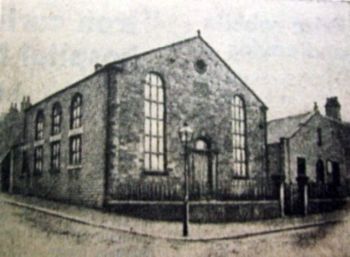
Original Howard Street Chapel
The United Free Methodists built the Howard Street Chapel in 1854 known as the Wesleyan Reform Chapel. A new chapel was built, the foundation stones being laid on 19 June, 1897, by James Bowden and Walter Harrison. The school foundation stones were laid on 31 March, 1893, by Mr Schofield, T Harrop, Miss M A Harrison, and Councillor B Platt (see The Platt family of Glossop). The Wesleyan Reformers also built the Ebenezer Chapel (the Stone of Help). It was built in 1854, and the lease, dated 24th of March, 1854 was made for 99 years to Thomas Bramhall. The plot of land contains 730 square yards, at a yearly rent of £2 2s. 0d.
The trustees were:
John Hampson,
Joseph Bennet,
Joseph Buckley,
James Fielding,
John Heap (quarryman),
Joseph Heap
Alexander Kellett,
Joseph Broadhurst,
James Sykes,
Jas. Ford,
Abner Hampson,
John Heap (weaver).
The Sunday school was opened on 20 August, 1854.
Zion Chapel, Methodist New Connexion, Simmondley Lane, was opened on 17 February, 1861, the foundation stone being laid on 25 August, 1860.
On 18 January, 1865, a large room in Station Road, Hadfield, was opened for preaching in connection with Hadfield Wesleyan Chapel.
There are also chapels at Chisworth and Tintwistle, built in 1834 and 1830 respectively.
The Primitive Methodists, another branch of the Wesleyan body, formed in 1810, built their first chapel in Glossop at Green Vale, near the Globe Inn. It was opened by George Horbury, Esq, of Liverpool, on 10 October 1835. The lease was dated 29th September, 1835, and was made out to Joshua Graham, overlooker, Littlemoor. The land was called the Warth, and was occupied by Francis J Sumner.
The area was East, 75 feet, bounded by Samuel Wilson's land; West, 75 feet, by vacant land; North, 72 feet, by Glossop Brook; South, 72 feet, Glossop and Marple Bridge Road. The trustees were:
Jonathan Goldthorpe,
Thomas Ellis,
Charles Jubb,
John Gill,
Samuel Lister,
Samuel Wilson,
Samuel Smith,
Thomas Johnson,
James Wharmby,
Joshua Jenkinson,
Samuel Beeley.
It was not an imposing structure, the total cost being £224 19s. 4½d. At the first anniversary sermons of the Sunday School, held August 5th, 1838, on the hymn papers was: “In consequence of the smallness of the place, silver will be gratefully received on entering the chapel.” The sermons were preached by the Rev. J. Peart, "from the Floating Chapel, Liverpool." This chapel was sold to Mr. Francis J. Sumner, who wanted the land. There is now a weaving shed on it. A new chapel was built in Shrewsbury Street, and opened on the 24th October, 1858, by the Rev. W. Rowe, of Manchester, the services the following Sunday were conducted by the Rev. Autcliffe, of Oldham, the united collections realising £72.
The trustees were:
The Rev. John Eastwood, Howard Town;
John Beeley, draper, Edward Street;
James Stubbs, joiner, Surrey Street;
John Cooper, iron and tinplate worker, Littlemoor;
George Goldsmith, grocer;
John Goldsmith, loom manager;
Joshua Berry, shopkeeper, Edward Street;
Robert Bramhall, weaver, Littlemoor;
and James Harrop, spinner, Littlemoor.

Princess Street Chapel, Whitfield
A Mission Church was opened in Princess Street, the trustees on the 10th July, 1893, being:
John Paulden, shoemaker, Shrewsbury Street;
John Berresford, spinner, Hague Street;
John Byrom, weaver, Princess Street;
Joseph James Shirt, spinner, Princess Street;
Joel Jarman, sawyer, Surrey Street;
Samuel Fletcher, railway clerk, Hadfield Street;
George Heywood Arnold, tailor, Wood Street;
John Beech, spinner, Broadbottom;
Herbert Holland, sorter, printworks, Broadbottom;
Jonathan Hawkins, clerk, Broadbottom;
and Joseph Henry Smith, weaver, Pikes Lane.
The lease of the Waterside Primitive Methodist Chapel is dated 6th December, 1844, and was made out to James Wharmby, the trustees being:
John Beeley,
John Wilson,
Elijah Stott,
James Haigh,
William Chadwick,
John Allcock,
George Batty,
Samuel Maddock;
and John Wharmby.
The present chapel was erected in 1876.
The Salvation Army have no place in Glossop of their own, but rent a room in the old Edward Street Mill. They do not seem to have made the same progress in Glossop as in other places, owing, no doubt, to the Blue Ribbon Army having got a firm hold of the class of people whom they generally get hold of.
The Gospel Union Mission Church since it has been refronted presents a very neat appearance. The foundation stones were laid by Mrs. R. Howton and Mrs. J Goldsmith on the 14th of July, 1888.
The old Parish Church in 1832 was in a very dilapidated condition, and at a public Vestry Meeting it was resolved to apply for a Faculty, which they did and obtained it on 19 June, 1832.
The Faculty states: “that by the great increase of the parishioners and inhabitants of the said parish (Glossop) there is not now sufficient accommodation in the said church for them to assemble therein to hear Divine Service performed and that the pews, seats and sitting places in the said church and are now much decayed and dilapidated, and that at the Vestry Meetings held in the vestry of the said church, pursuant to public notices, to take into consideration the state and condition of the interior of the said church, and to adopt means for its improvement by new pewing the same and making such alterations as the necessity of the case might require, and to obtain a Faculty for that purpose, it was unanimously agreed upon to take down the gallery at the West end, and also the pulpit and reading desk, pews, seats, and sitting places in the body of the said Church, and to erect a new gallery at the said West end, and two galleries over the North and South aisles thereof, and to erect the pulpit and reading desks, and new pew the body or ground floor of the said Church according to the plans hereunto annexed." This was done.
Henry Charles XIII, Duke of Norfolk, built the schools known as the Duke of Norfolk's Schools; they were opened on Saturday, April 10, 1852, when 1,600 persons had tea. The cost of the schools was £3000, and the contractor was Mr Thomas Wagstaffe, of Whitfield. The Duke also rebuilt the chancel and the steeple. The foundation stone of the steeple was laid by his Grace on Saturday, September 30, 1854. He also built a new vicarage, 1850.
It became necessary, owing to the rapid increase of the town, to build another church, and this was Saint James' Whitfield.
The foundation stones of the church and schools were laid by the Right Rev. John Lonsdale, DD, Lord Bishop of Lichfield, on Friday 27th September, 1845.
The Church was consecrated by him on Tuesday, 8th September, 1846.
The Bishop stayed for the night at Howard Town House, the residence of Mr John Wood, and had not the Bishop been a lover of fresh air, and slept with his bedroom window open, there would have had to have been a new Bishop, for he blew out the gas.
The late Samuel Wood, Esq. presented the church with a new organ, which was opened on 18th December, 1859.
The schools were enlarged in 1867, and have been enlarged several times since, a new school being now nearly completed.
The first commencement of St James' school was in a room over the Norfolk Arms stables.
On 17 August, 1854, the Hadfield church people had a bazaar to raise funds to enable them to build a Church School.
In November, 1854, the Duke of Norfolk made them a gift of 1600 square yards of land for the site, and in 1855 St Andrew's Schools were built at a cost of £850; a mission room was opened in Lees Street; and on 6th February, 1855, the first tea party in connection with it was held there.
The corner stone of the Church was laid on 30th November, 1872 by the late Rev. J D Knowles, MA, Vicar of the Ancient Parish of Glossop.
The Rev Joseph Hadfield entered upon his duties on 1 October, 1872 and is still in office.
Holy Trinity Church Schools were built in 1873 and the building of the Church was commenced directly afterwards, and was consecrated by the Right Rev G A Selwyn, Bishop of Lichfield, Saturday, July 31st, 1875.
A mission room was opened in George Street, and a new one built in High Street West, which is now used as a Church Club.
Talbot Street Day and Sunday Schools were erected to commemorate the Centenary of Sunday Schools, the foundation stone being laid August 14th, 1880. The foundation stone of St Luke's Church was laid by Mrs Wood, October 21, 1905.
I have only dealt briefly with the Churches of the Established Church, as I understand a local ecclesiastical friend of mine is preparing an account of them which will probably be published in book form.
The Unitarians over 40 years ago began to have meetings in the Town Hall, and met with strenuous opposition, which led to a Protestant Defence Association being formed.
They held their services in a room in Henry Street, near to the bank, but eventually, by the aid of Mr Edmund Potter, they built a chapel in Fitzalan Street, which was opened in June 8th, 1875, and is now used as a Sunday School.
The foundation stones of the present church were laid 27th of April, 1895, by George H Lee Esq (President of the Provincial Association), Capt.. Partington, J.P., Lady Roscoe, and Herbert Partington, Esq.
The cost of the church was about £2500.
The Roman Catholics in Glossop.
After Henry VIII’s quarrel with the Pope, Roman Catholics in this country were placed under very great difficulties in assembling for worship; it had to be done secretly. The lords of the Manor of Glossop being Roman Catholics, there were consequently Roman Catholics in Glossop. After they were allowed to worship, without hindrance, they worshipped at Glossop Hall, which was then the residence of the steward of the Glossop estate.
A rather curious coincidence is related with regard to one of the priests.
When the Rev Christopher Howe. was appointed Vicar of Glossop, in 1793, he travelled from Lancaster to Manchester in the stage coach with another clerical gentleman, and discovered that they were both going to Glossop.
The other was the Rev. Father J. Barbe, who was Roman Catholic priest until he died in 1827. The Church was not opened until 1836.
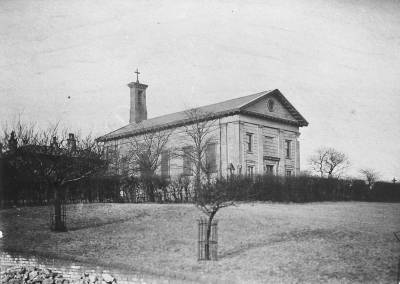
All Saints RC Church, Old Glossop.
The Roman Catholic Schools in St. Mary’s Road were commenced in August, 1853, and opened in 1854. Their cost was £1,300.
St. Charles Borromeo Roman Catholic Church at Hadfield was erected by the late Lord Howard, and opened on the 18th Feb., 1858.
It was stated at the opening that "Lord Howard has had the Church built under his own supervision, and had dedicated it to the Holy Catholic faith as a debt of gratitude to the Almighty God for the numerous favours which He has been pleased to bestow upon him."
On 31 August, 1861, a Cross was placed at the Church by the Friars Preachers as a memorial of their visit to Glossop.
On 2 June, 1860, the Roman Catholic portion of the cemetery was consecrated.
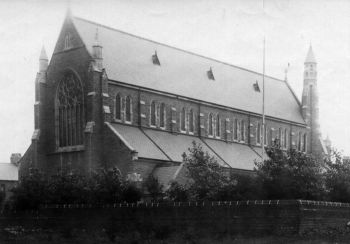
St. Mary Crowned Roman Catholic Church, Sumner Street,.
The late F.J. Sumner, who died so suddenly in London in June, 1884, died intestate. It had been his intention to build a Roman Catholic Church in St. James's Ward, but did not live to carry out his intentions. The relatives who benefited by his death, however, erected the fine Church in Sumner Street to his memory. A bottle was placed in the foundation stone, containing document which stated:
On the 3rd day of July, in the year of our Lord 1886, in the 50th year of the reign of Queen Victoria, and in the 9th year of the Pontificate of Pope Leo XIII. The foundation stone of this Church, erected to the honour of God, and dedicated to the Blessed Virgin Mary, founded by Francis James Sumner, Esq., J.P. D.L and as a monument to his memory, built and completed by his heirs—John Sumner, Esq., and his son F. J. Sumner, Esq., of Bickford, Tewksbury; George Westmeath, Esq., of Monmouth; John Sumner, Esq., of Studeley; Joseph Weetman, Esq., The Haywards, Taxall; Mrs. Elizabeth Smith, of Stone; William Sumner, Esq., of Newcastle-under-Lyme; Miss Eliza Sumner, of Newton Abbott; B. W. Latham, Esq., of Canada; and E. H. Butler, Esq., Australia, on this excellent site generously granted and conveyed for God's service for service for ever by the Right Honourable Baron, Lord Edward George Fitzalan Howard, of Glossop, and his son, Lord Francis Edward Fitzalan Howard, of Glossop; the Rev. Charles William Canon Tasker Being the Rector of the Church, by the Right Rev. Father in God, Edward G Bagshawe, DD, third Bishop of Nottingham, and in the 12th year of his episcopate was solemnly blessed and laid. Architect of the church, A E Dempster. Builder of the Church, JL Ward.
On 20 June, 1858, the annual open-air meeting of the Waterside and Woolley Bridge Religious Tract Society was held at Bankbottom.
At one time nearly every place of worship in the district delivered religious tracts out weekly; it was a good custom, and was a means of bringing the workers into touch with people who did not habitually attend a place of worship, and many were brought through these means to become regular attendance.
I often wonder why the practice was discontinued, and what became of the tracts.
In November, 1859, there was a spiritual revival in the district, there being united services of Church and Nonconformist, and since then there have been many carried out by the different religious bodies. Why not a united one again?
In 1864 the Sunday School Union was established.
By means of tea parties, sales of work, jumble sales, entertainments, bazaars, and, of late, whist drives and dances, a great deal of money has been raised to carry on the religious education of the parishioners.
It would be interesting to know the amount raised by all sects during the last 50 years.
Return to GJH.me Home Page, Return to Glossop Area Local Histories index.
Last updated: 9 November 2022








